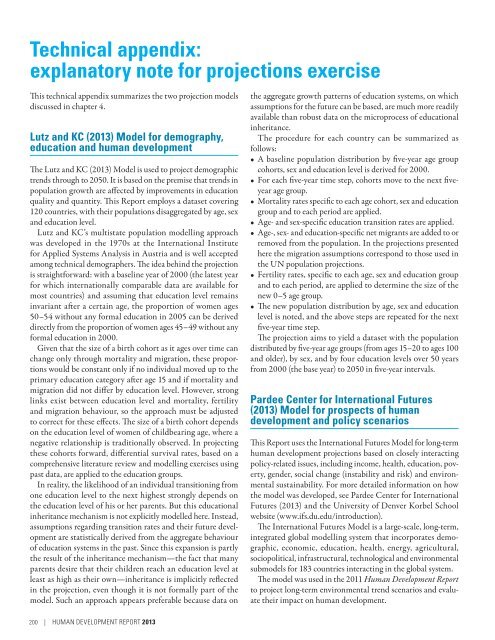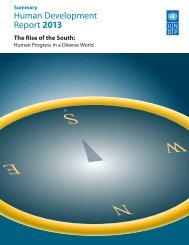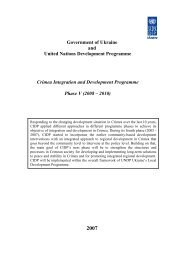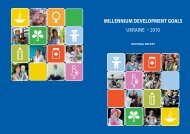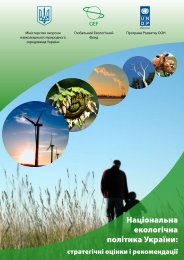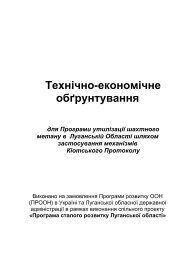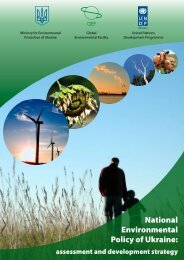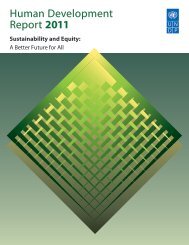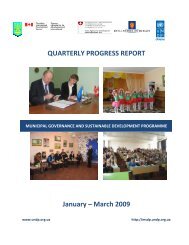E N S W - United Nations Development Programme
E N S W - United Nations Development Programme
E N S W - United Nations Development Programme
You also want an ePaper? Increase the reach of your titles
YUMPU automatically turns print PDFs into web optimized ePapers that Google loves.
Technical appendix:<br />
explanatory note for projections exercise<br />
This technical appendix summarizes the two projection models<br />
discussed in chapter 4.<br />
Lutz and KC (2013) Model for demography,<br />
education and human development<br />
The Lutz and KC (2013) Model is used to project demographic<br />
trends through to 2050. It is based on the premise that trends in<br />
population growth are affected by improvements in education<br />
quality and quantity. This Report employs a dataset covering<br />
120 countries, with their populations disaggregated by age, sex<br />
and education level.<br />
Lutz and KC’s multistate population modelling approach<br />
was developed in the 1970s at the International Institute<br />
for Applied Systems Analysis in Austria and is well accepted<br />
among technical demographers. The idea behind the projection<br />
is straightforward: with a baseline year of 2000 (the latest year<br />
for which internationally comparable data are available for<br />
most countries) and assuming that education level remains<br />
invariant after a certain age, the proportion of women ages<br />
50–54 without any formal education in 2005 can be derived<br />
directly from the proportion of women ages 45–49 without any<br />
formal education in 2000.<br />
Given that the size of a birth cohort as it ages over time can<br />
change only through mortality and migration, these proportions<br />
would be constant only if no individual moved up to the<br />
primary education category after age 15 and if mortality and<br />
migration did not differ by education level. However, strong<br />
links exist between education level and mortality, fertility<br />
and migration behaviour, so the approach must be adjusted<br />
to correct for these effects. The size of a birth cohort depends<br />
on the education level of women of childbearing age, where a<br />
negative relationship is traditionally observed. In projecting<br />
these cohorts forward, differential survival rates, based on a<br />
comprehensive literature review and modelling exercises using<br />
past data, are applied to the education groups.<br />
In reality, the likelihood of an individual transitioning from<br />
one education level to the next highest strongly depends on<br />
the education level of his or her parents. But this educational<br />
inheritance mechanism is not explicitly modelled here. Instead,<br />
assumptions regarding transition rates and their future development<br />
are statistically derived from the aggregate behaviour<br />
of education systems in the past. Since this expansion is partly<br />
the result of the inheritance mechanism—the fact that many<br />
parents desire that their children reach an education level at<br />
least as high as their own—inheritance is implicitly reflected<br />
in the projection, even though it is not formally part of the<br />
model. Such an approach appears preferable because data on<br />
the aggregate growth patterns of education systems, on which<br />
assumptions for the future can be based, are much more readily<br />
available than robust data on the microprocess of educational<br />
inheritance.<br />
The procedure for each country can be summarized as<br />
follows:<br />
• A baseline population distribution by five-year age group<br />
cohorts, sex and education level is derived for 2000.<br />
• For each five-year time step, cohorts move to the next fiveyear<br />
age group.<br />
• Mortality rates specific to each age cohort, sex and education<br />
group and to each period are applied.<br />
• Age- and sex-specific education transition rates are applied.<br />
• Age-, sex- and education-specific net migrants are added to or<br />
removed from the population. In the projections presented<br />
here the migration assumptions correspond to those used in<br />
the UN population projections.<br />
• Fertility rates, specific to each age, sex and education group<br />
and to each period, are applied to determine the size of the<br />
new 0–5 age group.<br />
• The new population distribution by age, sex and education<br />
level is noted, and the above steps are repeated for the next<br />
five-year time step.<br />
The projection aims to yield a dataset with the population<br />
distributed by five-year age groups (from ages 15–20 to ages 100<br />
and older), by sex, and by four education levels over 50 years<br />
from 2000 (the base year) to 2050 in five-year intervals.<br />
Pardee Center for International Futures<br />
(2013) Model for prospects of human<br />
development and policy scenarios<br />
This Report uses the International Futures Model for long-term<br />
human development projections based on closely interacting<br />
policy-related issues, including income, health, education, poverty,<br />
gender, social change (instability and risk) and environmental<br />
sustainability. For more detailed information on how<br />
the model was developed, see Pardee Center for International<br />
Futures (2013) and the University of Denver Korbel School<br />
website (www.ifs.du.edu/introduction).<br />
The International Futures Model is a large-scale, long-term,<br />
integrated global modelling system that incorporates demographic,<br />
economic, education, health, energy, agricultural,<br />
sociopolitical, infrastructural, technological and environmental<br />
submodels for 183 countries interacting in the global system.<br />
The model was used in the 2011 Human <strong>Development</strong> Report<br />
to project long-term environmental trend scenarios and evaluate<br />
their impact on human development.<br />
200 | HUMAN DevELoPMENt REPort 2013


